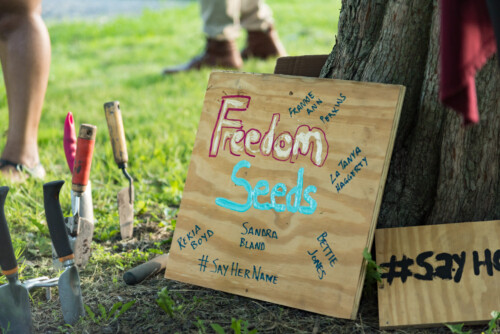Replacing the State with the Church
The religious right has the same response to both welfare and homosexuality: Accept Christ and all will be solved. Right-wing magazines and leaders who oppose any gay rights legislation repeatedly urge homosexuals to change their sexual orientation by joining their churches. Gay-conversion organizations like Exodus Ministries use language like, “there is hope for change through the power of God,”1 when they try to “recruit” homosexuals into their organizations. Likewise, many political leaders have been arguing for years that welfare should be dismantled completely and replaced by private charities, such as churches. For example, in one article, “A Faith-Based Alternative to the Welfare State,” the right-wing Family Research Council makes the argument that “dependence on God obviates the need for dependence on the state.”2
The immediate impact of the 1996 welfare reform upon queer people was not so different from the impact it had upon other low-income people. However, the next 15 years brought about welfare policies and programs that have had very distinct implications for queer people.
Marriage Promotion
One major product of welfare reform was marriage promotion, such as programs like the “Healthy Marriage Initiative.” These programs include a range of provisions designed to encourage women on welfare to get and stay married: deducting money from welfare checks when mothers are living with men who are not the fathers of their children, providing extra cash bonuses to recipients who get married, offering relationship and marriage education classes, and increasing monthly welfare checks for married couples. Several provisions specifically target Latino and African American communities. These programs were widely criticized by women’s organizations concerned about victims of domestic violence. However, the silence from the mainstream LGBT movement was rather widespread. Apparently, the threat that such programs posed to low-income lesbians who cannot legally get married was not of concern to most of our national LGBT organizations, presumably because the lesbians in question were low-income, and thus not of concern to our national organizations. I believe that economic security is a right that should apply to all people—single or married—and coercing poor women to get married in order to be able to survive is ineffective and disgusting public policy. We must also ask to what extent the push for gay marriage aligns with conservative and neoliberal modes of marriage promotion that are about establishing security and benefits through coupledom, rather than through public assistance provided by the government. New York Governor Andrew Cuomo’s support of gay marriage coexists with his overall economic austerity plan, including his various attacks on public services.
Fatherhood Initiatives
Various fatherhood initiatives are related to these programs. In 2006, Congress enacted a new program, “Grants For Healthy Marriage Promotion and Responsible Fatherhood,” authorizing grants of up to 50 million dollars per year for activities promoting “responsible fatherhood.” These programs have their roots in welfare reform, which allocated millions of dollars for things like “Responsible Fatherhood Programs” and “Partners for Fragile Families.” These programs targeted unemployed and underemployed noncustodial fathers with a range of services designed to force fathers to provide things such as child support and to undergo parenting instruction. As with marriage promotion programs, these programs raise the question of what happens to women, such as lesbian mothers (not to mention domestic violence victims), who do not want biological fathers involved in their children’s lives.
Charitable Choice
Created as part of PRA, “charitable choice” allowed government officials to purchase social services from religious providers using TANF, Welfare to Work, and other funds. In 2009 under President Obama, it became the White House Office of Faith-Based and Neighborhood Partnerships.
Many have voiced concern that charitable choice blurs the separation of church and state. Critics argue that federal financial support of churches creates the potential for the biased funding of groups affiliated with a particular religious denomination. Issues of proselytizing to clients and discriminatory hiring policies have already led to lawsuits. For queer people, the concerns should be obvious. Although there are many religious communities and organizations that are welcoming to LGBT people, many other American religious institutions (particularly those large enough to secure government funding) have a long history of intolerance of homosexuality. The prospect of having to seek help at a church where they feel unwelcome is enough to prevent many low-income queers from accessing needed services. This is an issue that should be of concern to all LGBT people, regardless of their income bracket.
Abstinence Only
When PRA passed in 1996, it allocated 50 million dollars per year over a five-year period for state abstinence-only education programs. In 2002, Congress voted to extend funding for these programs. Abstinence-only education programs (which are also funded by other federal programs, in addition to using welfare money) teach young people in schools that abstinence from sexual activity until marriage is the expected norm in this country. These programs teach that sexual expression outside of marriage will have harmful social, mental, and physical consequences, and that abstinence is the only way to avoid sexually transmitted diseases and unwanted pregnancy. These programs are not allowed to include discussion of the proper use of contraception, including condoms, as a way to reduce the risk of contracting HIV or other sexually transmitted diseases. Only failure rates of condoms can be discussed in these programs. These programs also leave out vital information about safe sex practices, sexual orientation, and abortion, as well as lacking education and socialization that would empower young people to live out their values and ideals in sexual relationships. Every reputable sexuality education organization and the American Medical Association have denounced abstinence-only education. The implications for queer people should be self-evident. When queer sexuality is, by definition, taking place outside of marriage, what message are these programs teaching our young people about themselves and their desires? When condom use is being dismissed as both immoral and ineffective, how many new cases of HIV are these programs responsible for?
Moving Forward
The question of whether or not poor people are entitled to government support has been debated in this country since its founding. The debate about who deserves help (and what kind, and how) is not over, even with the PRA’s dismantling of previous welfare policies. As we face reauthorization of welfare reform and engage in public policy debates about the social safety net in general, it is crucial that LGBT organizations get involved in the debates. To ignore these discussions, on the premise that they are not “gay issues,” is to assume that all LGBT people are middle class, which is simply not so. It also assumes that these policy debates have no implications for middle-class or affluent queer people. But looking at the tactics and results of the right’s attacks on poor people and queer people should make clear that welfare policy is indeed a queer issue—one that we can no longer afford to sit out.
- Curtis, C. (1996). “A Way Out: More ministries are offering homosexuals a chance to turn away from a life of destruction.” Christian American. July/August 1996. [↩]
- Marshall, J.E. (1995). “The Greatest of These is Love: A Faith-Based Alternative to the Welfare State”. Family Policy. Family Research Council. 1995. [↩]




